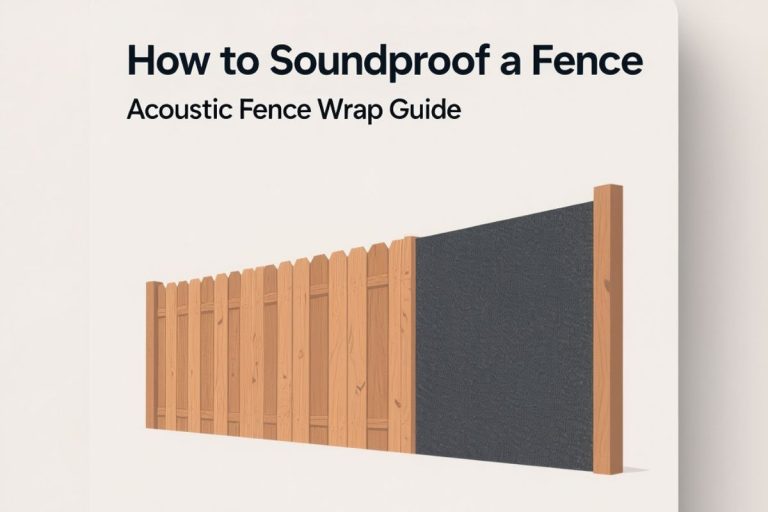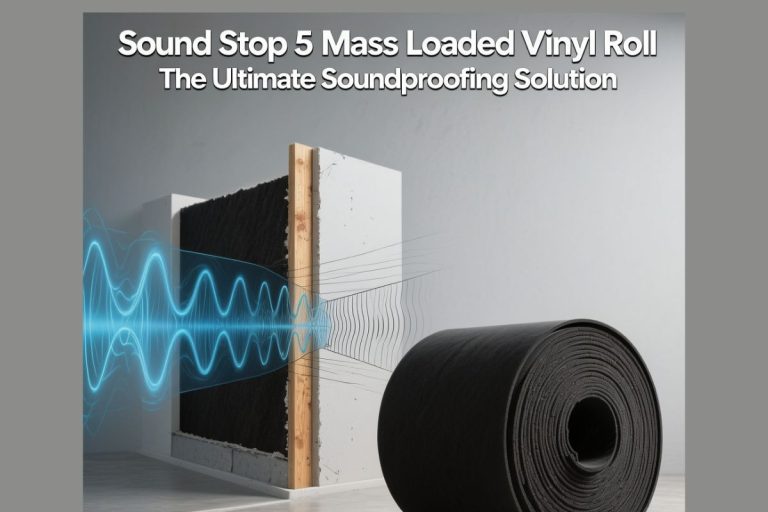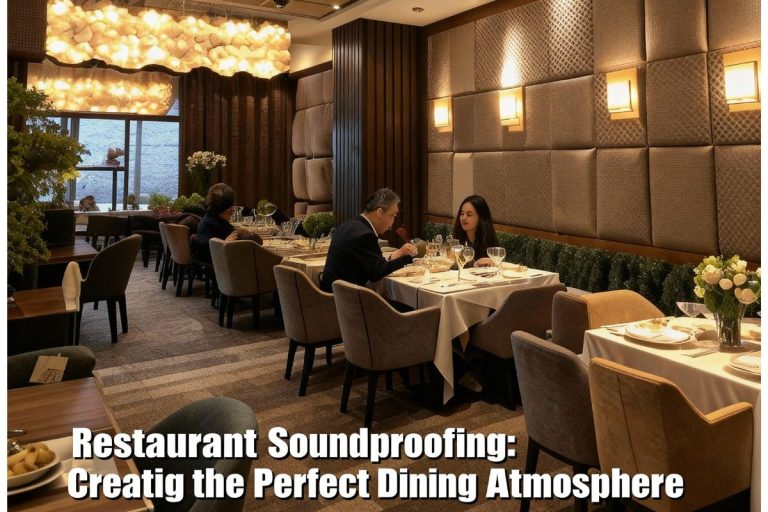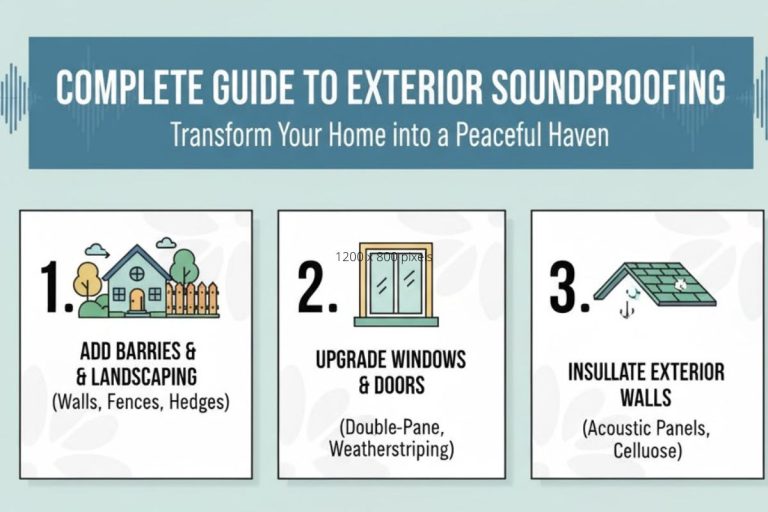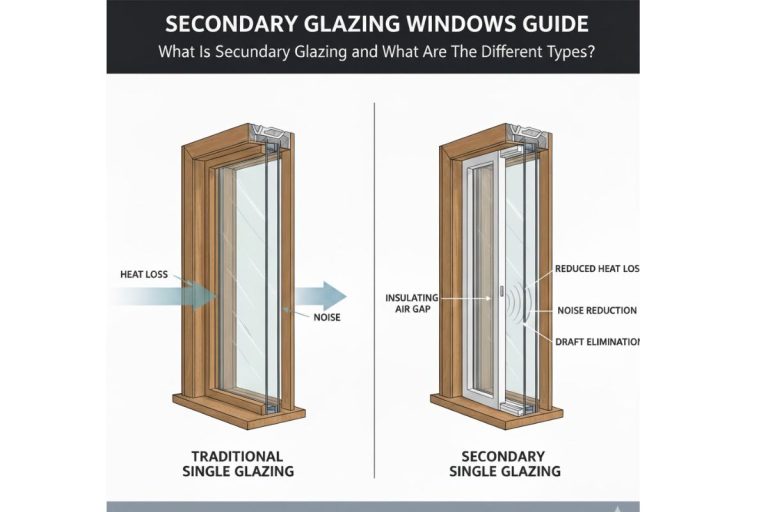Are you tired of noisy neighbors, traffic sounds, or loud music disturbing your sleep? Soundproofing for bedrooms might be the perfect solution you’ve been searching for. In this complete guide, we’ll show you exactly how to create the perfect quiet bedroom using proven soundproofing methods.
Tips for Soundproofing for Bedrooms
Creating a peaceful bedroom environment starts with understanding the basics of bedroom soundproofing. Here are essential tips that will help you achieve the quiet sleep space you deserve.
Start with Simple Solutions:
- Heavy curtains can block up to 50% of outside noise
- Door seals eliminate sound gaps immediately
- Thick carpeting reduces impact noise significantly
- Rearranging furniture can create natural sound barriers
Focus on Problem Areas:
- Identify where noise enters your bedroom most
- Check windows, doors, and shared walls first
- Look for gaps around electrical outlets
- Test different times of day for noise patterns
PEOPLE ALSO READ : How to Stop Noise from Your Neighbors: 15 Proven Solutions That Actually Work
Why to Soundproofing for Bedrooms
Quality sleep is essential for good health, and noise is one of the biggest sleep disruptors. Understanding why bedroom soundproofing matters will motivate you to take action.
Health Benefits of Quiet Bedrooms:
- Deeper, more restful sleep cycles
- Reduced stress and anxiety levels
- Better concentration during the day
- Improved immune system function
Common Bedroom Noise Problems:
- Traffic noise from nearby roads
- Neighbor conversations and music
- Household sounds like TV or appliances
- HVAC systems and air conditioning
Impact on Sleep Quality: Even low-level noise can reduce sleep quality by 20-30%. Your brain continues processing sounds during sleep, preventing you from reaching the deepest, most restorative sleep stages.
Methods for Soundproofing Your Bedroom
There are several effective approaches to bedroom soundproofing, ranging from simple DIY solutions to professional installations.
Soundproofing Bedroom Walls With Non-Invasive Methods
Acoustic Panels and Foam:
- Easy to install with adhesive backing
- Available in decorative patterns for bedroom aesthetics
- Effective for mid to high-frequency noise
- Removable for renters or temporary solutions
Heavy Blankets and Tapestries:
- Hang thick moving blankets on walls
- Use decorative tapestries that serve dual purposes
- Layer materials for increased effectiveness
- Cost-effective immediate solution
Barriers & Sound Insulation for Bedroom Walls
Mass Loaded Vinyl (MLV):
- Industry standard for sound blocking
- Can be installed behind existing drywall
- Effective against neighbor noise
- Long-lasting professional solution
Soundproof Insulation:
- Mineral wool provides excellent sound absorption
- Fiberglass insulation in wall cavities
- Cellulose for eco-friendly options
- Professional installation recommended
Acoustic Panels for Bedroom Walls
Types of Bedroom Acoustic Panels:
| Panel Type | Best For | Cost Range | Installation |
| Foam Panels | Budget Solution | $20-100 | Easy |
| Fabric Panels | Bedroom Decor | $50-200 | Medium |
| Wooden Panels | Luxury Look | $100-400 | Hard |
| Polyester Panels | Safety/Kids | $40-150 | Easy |
Controlling Noise From Doors
Bedroom doors are often the weakest link in soundproofing. Small improvements can make big differences.
Door Upgrade Options:
- Replace hollow doors with solid core doors
- Install acoustic door sweeps at the bottom
- Add door seals around the entire frame
- Use soundproof door blankets for temporary solutions
Door Sealing Process:
- Measure all gaps around door frame
- Install adhesive-backed door seals
- Add adjustable door sweep at bottom
- Test door closure and adjust as needed
Reducing Sound Through Floors
Floor soundproofing is crucial for bedrooms above noisy areas or for preventing sound transmission to rooms below.
Flooring Solutions:
- Thick carpet with quality padding
- Acoustic underlayment under hard floors
- Rubber mats for high-impact areas
- Cork flooring for natural sound absorption
Impact Noise Reduction: Floor soundproofing primarily addresses impact noise – footsteps, dropping objects, and furniture movement. This is especially important in multi-story homes or apartments.
Flooring Underlayments
Best Underlayment Materials:
- Rubber: Maximum impact noise reduction
- Cork: Natural and sustainable option
- Foam: Budget-friendly basic solution
- Mass Loaded Vinyl: Professional-grade blocking
Installation Tips:
- Cover entire floor area without gaps
- Overlap seams by 2-3 inches
- Use appropriate adhesives for your flooring type
- Consider moisture barriers in humid climates
Door Seals & Door Sweeps
Door Seal Types:
- Adhesive Seals: Easy installation, good for renters
- Compression Seals: Better performance, permanent installation
- Magnetic Seals: Easy to replace, moderate effectiveness
- Adjustable Sweeps: Customizable gap closure
Installation Process:
- Clean door frame thoroughly
- Measure and cut seals to proper length
- Apply seals starting from top, working down
- Test door operation and adjust if needed
Acoustic Panels
Panel Placement Strategy:
- Focus on reflection points where sound bounces
- Install at ear level when sitting on bed
- Cover 25-30% of wall surface for effectiveness
- Distribute panels evenly across problem walls
DIY Acoustic Panel Creation:
- Use rockwool or fiberglass insulation
- Wrap in acoustic fabric
- Build simple wooden frames
- Mount securely to wall studs
Cutting Down Ceiling Noise
Ceiling soundproofing addresses noise from upstairs rooms, HVAC systems, and structural sounds.
Ceiling Soundproofing Options:
- Acoustic ceiling tiles for easy installation
- Mass loaded vinyl above existing ceiling
- Resilient channels for sound isolation
- Drop ceiling systems with insulation
Addressing Upstairs Neighbors:
- Install acoustic ceiling tiles
- Use Green Glue between drywall layers
- Add extra insulation in ceiling cavities
- Consider white noise machines as supplement
Stopping Outside Noises From Getting Through Your Windows
Windows are major weak points for bedroom soundproofing. Traffic, construction, and outdoor activities often enter through windows.
Window Soundproofing Solutions:
- Soundproof Curtains: Immediate improvement, easy installation
- Acoustic Window Inserts: Custom-fitted secondary glazing
- Storm Windows: Permanent exterior installation
- Window Plugs: Removable inserts for maximum blocking
Curtain Selection Guide:
- Look for multiple layers of dense fabric
- Choose curtains that extend beyond window frame
- Consider thermal backing for added mass
- Install on ceiling-mounted tracks for better seal
Using Furniture to Your Advantage
Strategic furniture placement can significantly improve bedroom soundproofing without additional materials.
Furniture Soundproofing Tips:
- Place bookcases against shared walls
- Use upholstered headboards as sound absorbers
- Position wardrobes to block noise sources
- Add soft furnishings like cushions and throws
Natural Sound Absorbers:
- Thick mattresses and pillows
- Upholstered chairs and ottomans
- Heavy curtains and drapes
- Wall-mounted fabric art
Renovating Your Bedroom for Better Soundproofing
For maximum soundproofing effectiveness, renovation projects offer the best opportunity for comprehensive solutions.
Renovation Soundproofing Options:
- Double drywall with Green Glue compound
- Staggered stud construction
- Rockwool insulation in all wall cavities
- Acoustic caulk at all joints and penetrations
Planning Your Renovation:
- Assess current noise levels and sources
- Set realistic budget for materials and labor
- Choose appropriate soundproofing methods
- Plan construction sequence to minimize disruption
The Best Soundproofing Wall Panels for Bedrooms
Top Wall Panel Recommendations:
Primacoustic Broadway Panels:
- Professional-grade acoustic treatment
- Beveled edges for seamless installation
- Available in multiple colors
- Excellent for bedroom aesthetics
Auralex Studiofoam Panels:
- Budget-friendly foam solution
- Easy installation with adhesive
- Good for mid-range frequencies
- Multiple thickness options
Acoustic Solutions Fabric Panels:
- Custom colors and patterns available
- Superior sound absorption
- Professional appearance
- Suitable for bedroom decor
What is Soundproofing Again?
Soundproofing is the process of reducing or eliminating sound transmission between spaces. In bedrooms, this means creating a barrier that prevents outside noise from disturbing your sleep.
Key Soundproofing Principles:
- Mass: Heavy materials block sound waves
- Absorption: Soft materials soak up sound energy
- Isolation: Separating surfaces prevents vibration transfer
- Sealing: Eliminating air gaps stops sound leaks
Soundproofing for Bedrooms – The Best Wall Panels
Professional Wall Panel Systems:
- QuietRock: Specialized soundproof drywall
- Roxul Safe’n’Sound: Mineral wool insulation
- Green Glue: Acoustic compound for layered construction
- Resilient Channels: Vibration isolation hardware
Installation Best Practices:
- Stagger panel joints to prevent sound flanking
- Use acoustic sealant at all edges
- Install panels flush against existing surfaces
- Consider professional installation for best results
Going Above and Beyond – Renovating Walls for Total Soundproofing
Advanced Wall Construction:
- Room-in-Room: Complete acoustic isolation
- Floating Walls: Decoupled construction
- Multiple Barriers: Layered mass loaded vinyl
- Acoustic Caulking: Seal every penetration
Professional Installation Benefits:
- Guaranteed performance levels
- Proper acoustic testing
- Building code compliance
- Long-term warranty coverage
Once the Walls Are Complete, Don’t Forget the Door and Windows!
Complete Bedroom Soundproofing Checklist:
- Wall soundproofing installed
- Door upgraded and sealed
- Windows treated with appropriate solutions
- Ceiling addressed if needed
- Floor underlayment installed
- Acoustic panels positioned strategically
Final Sealing Steps:
- Caulk all electrical outlets
- Seal light switches and fixtures
- Address any remaining gaps
- Test overall noise reduction
How to Soundproof a Room 100%
Complete Room Soundproofing Process:
Step 1: Assessment and Planning
- Measure current noise levels with decibel meter
- Identify all sound entry points
- Set realistic goals for noise reduction
- Plan construction sequence
Step 2: Structural Soundproofing
- Install mass loaded vinyl barriers
- Add acoustic insulation in wall cavities
- Use resilient channels for isolation
- Apply acoustic sealant throughout
Step 3: Surface Treatments
- Install acoustic panels on walls
- Add soundproof curtains to windows
- Place carpet with padding on floors
- Seal all doors and windows
PEOPLE ALSO READ : Complete Guide to Exterior Soundproofing: Transform Your Home into a Peaceful Haven
How to Soundproof a Room in 3 Steps
Quick Soundproofing Process:
Step 1: Know the Difference Between Sound Proofing vs Sound Absorbing
- Soundproofing: Blocks sound from entering or leaving
- Sound Absorbing: Reduces echo and reverberation inside room
- Best Results: Combine both approaches for maximum effectiveness
Step 2: Identify Your Source of Noise
- Traffic noise requires heavy barriers
- Neighbor voices need wall soundproofing
- Impact noise needs floor treatments
- HVAC noise requires duct treatments
Step 3: Choose the Right Materials
- Dense materials for blocking (MLV, concrete)
- Soft materials for absorbing (foam, fabric)
- Appropriate thickness for your noise level
- Materials suitable for bedroom environment
How To Soundproof A Room
Comprehensive Room Soundproofing Guide:
Planning Phase:
- Assess room acoustics and noise sources
- Set budget for materials and installation
- Choose appropriate soundproofing methods
- Plan for aesthetic considerations
Material Selection:
- Barriers: MLV, dense drywall, concrete
- Absorbers: Foam, fabric panels, insulation
- Sealers: Acoustic caulk, weatherstripping
- Isolators: Resilient channels, rubber pads
Installation Process:
- Start with structural elements
- Install barriers before absorbers
- Seal all gaps and penetrations
- Test and adjust as needed
How to Soundproof a Room Cheaply from Traffic and Neighbours
Budget-Friendly Solutions:
Under $100 Options:
- Heavy moving blankets: $30-50
- Door weatherstripping: $10-20
- Foam panels: $40-80
- Thick curtains: $50-100
DIY Installation Tips:
- Use temporary adhesives for renters
- Repurpose household items as sound absorbers
- Focus on the most problematic areas first
- Layer solutions for improved effectiveness
Why Is Sound so Difficult to Contain?
Physics of Sound Transmission:
- Sound waves travel through air, solids, and liquids
- Low-frequency sounds penetrate materials more easily
- Sound finds the weakest path through structures
- Vibrations can travel through building frames
Common Soundproofing Challenges:
- Flanking Paths: Sound traveling around barriers
- Air Gaps: Even small openings reduce effectiveness
- Structural Transmission: Vibrations through building materials
- Frequency Variation: Different sounds require different solutions
Can You Make a Room Completely Soundproof?
Realistic Expectations:
- 100% soundproofing is extremely difficult and expensive
- 80-90% noise reduction is achievable with proper methods
- Professional studios achieve near-complete isolation
- Most bedrooms can reach comfortable quiet levels
Factors Affecting Complete Soundproofing:
- Construction budget and methods
- Types of noise sources present
- Building structure and materials
- Local building codes and restrictions
Where Is the Sound Coming From?
Common Bedroom Noise Sources:
External Sources:
- Traffic noise from streets
- Construction and maintenance activities
- Neighbor yard activities
- Emergency vehicle sirens
Internal Sources:
- HVAC system operation
- Household appliances
- Family member activities
- Pet noise
Structural Sources:
- Building settling sounds
- Plumbing noise
- Electrical system sounds
- Ventilation system noise
The Most Common Soundproofing Methods Include:
Primary Soundproofing Techniques:
- Mass Addition: Adding weight to surfaces
- Absorption: Using porous materials
- Isolation: Decoupling surfaces
- Sealing: Eliminating air gaps
Material Categories:
- Barriers: Block sound transmission
- Absorbers: Reduce reflected sound
- Dampers: Convert sound energy to heat
- Isolators: Prevent vibration transfer
How to Make a Room Soundproof from Traffic Noise
Traffic Noise Characteristics:
- Low-frequency rumbling from vehicles
- Constant background noise levels
- Periodic loud sounds (sirens, motorcycles)
- Varies by time of day and weather
Effective Solutions for Traffic Noise:
- Heavy Curtains: Immediate improvement
- Mass Loaded Vinyl: Professional-grade blocking
- Storm Windows: Permanent exterior solution
- White Noise: Masking remaining sounds
How to Soundproof Windows for Noise Reduction in a Room
Window Soundproofing Options:
Temporary Solutions:
- Soundproof curtains with thermal backing
- Removable acoustic window inserts
- Temporary caulking around frames
- Heavy blankets hung over windows
Permanent Solutions:
- Storm window installation
- Acoustic window replacement
- Professional glazing upgrades
- Structural window modifications
How to Soundproof a Room from Noisy Neighbours
Neighbor Noise Solutions:
- Shared Wall Treatment: MLV and acoustic panels
- Floor Soundproofing: Underlayment and carpeting
- Ceiling Treatment: Acoustic tiles or panels
- Door Sealing: Comprehensive gap elimination
Apartment-Specific Considerations:
- Renter-friendly removable solutions
- Thin wall construction challenges
- Shared ventilation systems
- Building policy restrictions
Can You Soundproof Existing Walls?
Existing Wall Soundproofing Methods:
- Surface Mounting: Acoustic panels over drywall
- Injection Methods: Blown-in insulation
- Overlay Systems: MLV attached to existing walls
- Renovation Approaches: Adding drywall layers
Non-Destructive Options:
- Acoustic panels with adhesive mounting
- Fabric-wrapped fiberglass panels
- Decorative sound-absorbing materials
- Furniture-based soundproofing
What Is the Cheapest Way to Soundproof a Wall?
Budget Wall Soundproofing:
- Moving Blankets: $30-50 for temporary solution
- Foam Panels: $40-100 for basic absorption
- Heavy Curtains: $50-150 for windows
- Weatherstripping: $10-30 for gap sealing
DIY Installation Savings:
- Save 50-70% on labor costs
- Use household tools for installation
- Purchase materials in bulk for discounts
- Prioritize high-impact areas first
How to Soundproof Ceilings and Floors Adjoining a Neighbour
Ceiling Soundproofing:
- Acoustic Tiles: Easy installation, good performance
- Drop Ceiling: Maximum isolation, professional look
- MLV Installation: Behind existing ceiling
- Resilient Channels: Vibration isolation
Floor Soundproofing:
- Carpet and Padding: Immediate impact noise reduction
- Acoustic Underlayment: Professional solution
- Rubber Mats: High-impact areas
- Cork Flooring: Natural sound absorption
How to Soundproof a Bedroom
Complete Bedroom Soundproofing Process:
Phase 1: Assessment
- Identify primary noise sources
- Measure current noise levels
- Set realistic goals and budget
- Plan installation sequence
Phase 2: Major Installations
- Install wall soundproofing materials
- Upgrade doors and windows
- Address ceiling and floor issues
- Seal all penetrations
Phase 3: Fine-Tuning
- Add acoustic panels for absorption
- Install soft furnishings
- Test noise levels and adjust
- Optimize room acoustics
DIY Ways to Soundproof a Room Cheaply
Cost-Effective DIY Solutions:
Free or Low-Cost Options:
- Rearrange furniture for natural barriers
- Use existing blankets and pillows
- Seal obvious gaps with household items
- Close unused doors and windows
Budget Material Solutions:
- Pool noodles for gap sealing
- Egg cartons for basic absorption (fire hazard – use carefully)
- Towels under doors
- Cardboard and fabric DIY panels
Noise Reduction Windows
Window Upgrade Options:
- Double-Pane: Standard upgrade for most homes
- Triple-Pane: Maximum performance for extreme noise
- Laminated Glass: Acoustic-specific glazing
- Gas-Filled: Argon or krypton for sound dampening
Window Treatment Accessories:
- Acoustic window inserts
- Soundproof window film
- Heavy thermal curtains
- Plantation shutters for dual benefits
PEOPLE ALSO READ : How to Soundproof a Fence with Acoustic Fence Wrap Guide
Case Study: Complete Bedroom Soundproofing Transformation
The Challenge: Maria’s bedroom faced a busy intersection with 24-hour traffic, construction noise, and nearby nightlife. Sleep disruption was affecting her work performance and health.
The Solution Implemented:
- Wall Soundproofing: Installed MLV on street-facing walls ($600)
- Window Treatment: Added acoustic window inserts ($400)
- Door Upgrade: Replaced hollow door with solid core plus seals ($300)
- Ceiling Treatment: Installed acoustic tiles ($250)
- Floor Addition: Added thick carpet with quality padding ($450)
- Finishing Touches: Acoustic panels and heavy curtains ($200)
Measurable Results:
- Before: 72 dB average noise level
- After: 42 dB average noise level
- Reduction: 30 dB (equivalent to 8x quieter)
- Sleep Quality: Improved from 3-4 hours to 7-8 hours nightly
- Total Investment: $2,200
- Installation Time: Two weekends
Maria’s Testimonial: “The transformation is incredible! I went from barely sleeping 3-4 hours per night to getting full, restful sleep. The installation was manageable over two weekends, and the results exceeded my expectations. My productivity at work has improved dramatically, and I feel like a new person. Best money I’ve ever spent on my health and wellbeing!”
Conclusion
Soundproofing for bedrooms is essential for creating the peaceful sleep environment you deserve. From simple DIY solutions like soundproof curtains and door seals to comprehensive renovation projects, there are options for every budget and situation.
Key Takeaways:
- Start Simple: Basic solutions like curtains and seals provide immediate improvement
- Layer Approaches: Combine different methods for maximum effectiveness
- Focus on Weak Points: Address doors, windows, and shared walls first
- Consider Long-Term: Invest in quality materials for lasting results
- Professional Help: Complex projects benefit from expert installation
Remember that even small improvements can make significant differences in your sleep quality. Whether you choose budget-friendly DIY solutions or invest in professional soundproofing, the improvement to your quality of life will be worth the effort.
READ MORE : Super Converters


